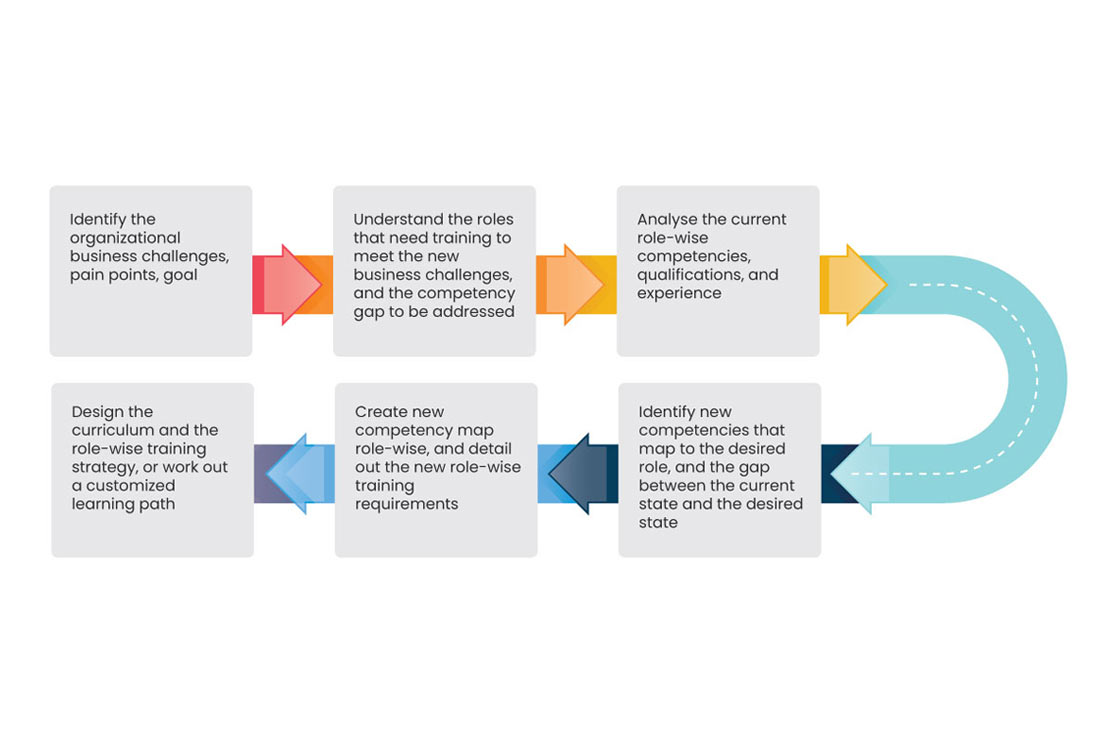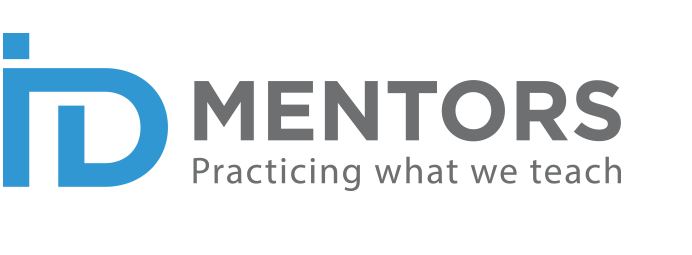OVERVIEW
Needs assessment is role-wise assessment of skill gaps between the current state and the desired state, and identifying the learning needs to close the gaps and ensure effective workplace performance. The outcome of needs assessment results in effective training solutions that impact the business growth of the customer in a positive way. While needs assessment is a highly iterative process, and you can never have enough of discussions to be sure that you and your stakeholder are on the same page with regard to the roles or tasks or responsibilities or competencies, and there can be many sub-processes that you may have to improvise, abroad level needs assessment process sequence can be charted out.

STEP 1 – IDENTIFYING CHALLENGES
Needs Assessment is a process by which we figure out the training needs of a group or groups, of a few roles in an organization, or all roles of an organization. The organization can be small, medium, or large. Therefore, the needs assessment process, though similar in all cases, have to be customized depending on the requirements of the customer – where the requirements can be explicit, implicit, or evolutionary in nature.
The initial questions or the “Day 1-2” questions that the needs assessor should ask is: What is your organization trying to accomplish? What are the business goals that your organization is trying to achieve?
The responses from stakeholders may be noticeably clear or partly clear and/or partly fuzzy. That’s absolutely fine. That is the nature of the assignment. The assessor needs to start a conversation with the customer stakeholders at this point. Many important points come out during a random conversation and assessors have to be very attentive. To make things easier, assessors can prepare a detailed questionnaire before traveling to the customer site.
The questionnaire can have generic questions, which can be customized after the initial introductory rounds and then distributed to the stakeholders to get their response or thoughts. Questions initially can be asked in any order. You can even, not ask any questions. Just listen to the leaders talking and make a mental note of their requirements, their pain points, or their business goals. At this stage you may not understand much of it. You will slowly – do not get thrown off your chosen track. You are there to stay for a while. Things will open up sooner or later. Don’t rush. There is no strict timeline to complete a “talk”. Never.
Here are some some sample questions to ask on the first meet with the customer:
- What is the need at this point for a training needs assessment? Is there a strong business compulsion?
- Who are the stakeholders in this endeavour?
- Can a meeting be organized with each of these stakeholders, as they lead different departments? If yes, by when?
- Can a meeting be organized with a few key members of each department? If yes, by when?
- What are the business goals of each of these departments? How do they map to the organizational goal?
- What are the primary roles in each of the department? What are the responsibilities of each role?
- In a particular role, what are the employees’ current level of proficiency and what is the desired level of proficiency?
- What are their educational qualifications? Are they motivated to achieve the business goals? Will it clash in anyway with their growth aspirations? (Subjective questions are important as they give us a definite direction on the organizational goal)
- What are the pain points of the organization, and of the employee group?
- Dothe pain points map to a training need(s) or the pain points require a totally different kind of solution, besides training?
- Is workplace performance at the current level of proficiency also a problem?
These and similar questions can be the base initial discussion that the assessor should have with the customer side stakeholders. The way analysis is done in a simple eLearning project, similarly these question-answer sessions help the assessor understand the business goals and analyse the employee performance problems. However, these discussions are not cast in stone. Bigger the organization, larger the requirement, and more the number of interactive and iterative sessions.
The assessor also needs to talk to the next level of leaders, who are on the floor, to get their point of view regarding the pain points, their proficiency level, and their aspirations. Understanding employee aspirations is also an important step towards ensuring that the right kind of needs are found and addressed. This happens with the knowledge of the supervisors and there is no organization-employee conflict out there.
Next, the questionnaire evaluation report is presented to the customer and the actual business challenges are documented by mutual agreement.
Some examples of business challenges can be:
- Ineffective implementation of safety and compliance procedures resulting in near-miss accidents or injury
- Managing a huge customer project
- Training new hires globally with language, culture, and other demographic barriers
- Aging workforce, ready to retire, and adequate transfer of knowledge
- Current level of competencies has gaps; performance is an issue
- Key responsibility areas are not well defined, overlapping responsibilities
STEP 2, 3 and 4 – ANALYSIS OF CURRENT AND FUTURE NEEDS; AN ITERATIVE PROCESS
After the assessor understands the business performance goal and pain points, the assessor needs to understand the roles that will have to be considered on priority to meet the challenge through appropriate training intervention. In this step, the assessor also needs to understand the current jobs/tasks of the role or roles, the future roles and responsibilities, and the competency gap that has to be closed for them to perform at the desired level. There are a number of tools that the assessor can use to understand the current situation and how far the employees are from the desired situation.
Some of the tools are:
- Individual interviews
- Focus groups
- Observations
- Reports
- Surveys
Based on the findings, the assessor will arrive at the actual desired situation. The gap between the actual and desired will provide the learning requirement.
Here is an example:
A leading oil and gas organization was unable to improve the performance effectiveness of its refinery operators despite conducting intensive training. They also did not have any methodology to capture the knowledge of it aging workforce who were due for retirement. The assessor assessed the current situation and discovered that training was mostly conducted in classroom using presentations and very text intensive training tools. Learning was mostly on-the-job with a mentor shadowing a few hundred employees. Training was therefore not consistent, and rarely measured. The material was outdated, and new hires were dependent on-the-job mentoring by experienced workforce for upgrading their skills. The desired situation was to have a formal training in place that will be able to measure employee performance.
STEP 5 – CREATE COMPETENCY MAP ROLE-WISE, AND NEW ROLE-WISE TRAINING REQUIREMENTS
To carry forward the case of the oil and gas organization, let’s look at an example to understand more about competencies.
For example, equipment knowledge could be a skill. In some customer engagements that the organization may have, this knowledge could be a challenge as the skill is usually not documented. The assessor in such a situation will need to discuss with all relevant roles and understand the competency level that they currently have, and the new level of competency they desire to have. Based on this information, the assessor will be able to create a new competency map role-wise and detail out the new role-wise training requirements so far as equipment knowledge is concerned.
The purpose of identifying competencies is to have a clear criterion to measure the skill and performance effectiveness of the target audience. Competency map is the formal documentation of skills and knowledge required for a particular role.
Each competency can have different levels of proficiency depending on the skill level required for a role who is assigned a particular job. For example, a junior instructional designer needs to have only storyboarding capabilities after understanding the design document, but a senior designer will need to be able to create the design document. However, both the instructional designer role will require common competencies of writing and comprehension. Pretty colourful, isn’t it?😊Well yes, when you map the different roles to different tasks to different competencies and different training requirements, it is best to colour code the excel worksheet. Makes it easier for the assessor and the approver.
STEP 6 – CURRICULUM DESIGN, TRAINING STRATEGY ROLE-WISE OR A CUSTOMIZED LEARNING PATH
Now that the assessor is aware of the target audience, the competencies and the learning methodology needed to achieve the learning objective, the assessor needs to identify training topics and create a curriculum design. This might require consultation with a subject matter expert if it is a technical content. An essential aspect of needs assessment is identifying the appropriate learning methodology to train the target audience. Somewhere in steps 1 through 4, the assessor also needs to understand the demographic, education, working and social background of the target audience. That will help the assessor create a curriculum design or a customized learning path using appropriate learning strategies to get effective training outcome.
As instructional designers turned assessors, you need to be aware of the different learning methodologies that can be adopted and map them to the requirements. Some common learning methodologies include:
- Coaching and mentoring
- Curated content
- Blended learning
- Web- based learning
- Classroom-based learning
- Mobile or micro learning
- Collaborative platform
- Game-based learning
Curriculum design provides clarity on the course names, course objectives, topics covered, duration, and the mode of delivery. Needs assessment is considered complete when the assessor prepares the training strategy for the entire requirement. In this document, the training goal, and the training process with the details of curriculum is documented. This document also guides the customers on how they should conduct the training as it includes the schedule of courses. It provides clarity on the training approach and broad level instructional strategies that can be used for developing the curriculum.
Once this is approved, the assessor, who is bored with Earl Greys and subways, can start dreaming of Lipton Darjeeling and a sumptuous meal back home. However, the work has just begun. Now the vendor organization needs to ramp up for creating the huge training content.
CONCLUSION
Needs assessment is a scientific and organized approach to analysing customer requirements from a competency-based learning perspective. Creating a competency map that elaborates on roles, responsibilities, tasks, and the skills required to complete those tasks, is the ultimate step to achieving training excellence for the customer organization. It is an ideal way of providing thought leadership to the customer. A successful needs assessment phase is not limited to just the deliverables from that phase. It creates a lasting impression in the mind of the customer that they have invested in the right place. Finally, as a learning consultant, assessors should be able to provide a real-time, implementable, and useful training solution that provides a win-win situation for both the vendor and the customer.



0 responses on "Needs Assessment - Part 3"